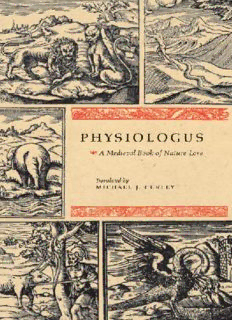
Physiologus: A Medieval Book of Nature Lore PDF
Preview Physiologus: A Medieval Book of Nature Lore
PHYSIOLOGUS university of chicago press chicago & london The University of Chicago Press, Chicago 60637 The University of Chicago Press, Ltd., London © 1979 Michael J. Curley Note to the Paperback Edition © 2009 Michael J. Curley All rights reserved. Originally published 1979 University of Chicago Press edition 2009 Printed in the United States of America 18 17 16 15 14 13 12 11 10 09 2 3 4 5 6 7 isbn-13: 978-0-226-12870-2 (paper) isbn-10: 0-226-12870-9 (paper) The woodcuts in this edition are reproduced from the 1587 G. Ponce de Leon edition of Physiologus, courtesy of the Newberry Library, Chicago. The initial research of this work was made possible in part through grants from the National Endowment for the Humanities, a federal agency whose mission is to award grants to support education, scholarship, media programming, libraries, and museums in order to bring the results of cultural activities to the general public. Library of Congress Cataloging-in-Publication Data Physiologus. English. Physiologus / translated by Michael J. Curley. p. cm. Includes bibliographical references. isbn-13: 978-0-226-12870-2 (alk. paper) isbn-10: 0-226-12870-9 (alk. paper) 1. Bestiaries. I. Curley, Michael J., 1942– II. Title. PA4273.P8E5 2009 883’.01—dc22 2009013135 The paper used in this publication meets the minimum requirements of the American National Standard for Information Sciences—Permanence of Paper for Printed Library Materials, ansi z39.48-1992. TO G. KARL GALINSKY tu duca, tu signore, etu maestro CONTENTS Introduction ix-xliii Note to the Paperback Edition xlv I. Webeginfirstofallbyspeakingofthe Lion 3 II. On the Antelope 4 III. OnPiroboli Rocks 6 IV. On the Swordfish 6 v. On the Charadrius 7 VI. On the Pelican 9 VII. On the Owl 10 VIII. On the Eagle 12 IX. On the Phoenix 13 X. On the Hoopoe 14 XI. On the Wild Ass 15 XII. On the Viper 15 XIII. On the Serpent 16 XIV. On the Ant 20 XV. On the Siren and Ass-Centaur 23 XVI. On the Hedgehog 24 XVII. On the Ibis 25 XVIII. On the Fox 27 XIX. On the PeridexionTree and the Doves 28 XX. On the Elephant 29 XXI. On Amos the Prophet 32 XXII. On the Roe 33 XXIII. On the Agate-stone 34 XXIV. On the Oyster-stone and the Pearl 34 xxv. On the Adamant-stone 38 XXVI. On the OtherNature ofthe Wild Ass and the Monkey 38 XXVII. On the Indian-stone 40 XXVIII. On the Heron, that is, the Coot 40 XXIX. On the FigTree 41 XXX. On the Panther 42 XXXI. On the Whale, that is, the Aspidoceleon 45 viii XXXII. On the Partridge 46 XXXIII. On the Vulture 47 XXXIV. On the Ant-lion 49 xxxv. On the Weasel 50 XXXVI. On the Unicorn 51 XXXVII. On the Beaver 52 XXXVIII. On the Hyena or the Brute 52 XXXIX. On the Niluus 53 XL. On the Echinemon 54 XLI. On the Little Crow 54 XLII. On the Ostrich 55 XLIII. On the Turtle-dove 56 XLIV. On the Swallow 58 XLV. On the Stag 58 XLVI. On the Frog 60 XLVII. On the Lizard, that is, the Salamander 61 XLVIII. On the Magnet 61 XLIX. On the Adamant-stone 62 L. On the Doves 64 LI. On the Sun-lizard, that is, the Sun-eel 66 Notes IMichael J. Curley INTRODUCTION P hysiologus was one ofthe most popular and widely read books ofthe Middle Ages. Some ofthe legends con cerningbeasts, stones, and trees which are found alle- gorized in Physiologus were part of folklore as early as Herodotus, andtheyhavecontinuedtoexerciseastrong influence on literature and the decorative arts down to the present day.1 The reason is not far to seek: we all love simple, well-told stories for their own sake. And, if a bit ofexotic lore can be mingled with useful moral instruction, so much the better. We never stop to ask that animal stories be zoologically accurate, for that would be missing theirpoint. The charm ofthese leg ends lies in their simplicity, one might even say in their naIvete, but their popularity was assured by their ready adaptability to a variety ofcultural contexts, reli gious as well as secular. Beginning as Indian, Hebrew, orEgyptianlegends, theypassedintoGreekandRoman folklore, poetry, and art, ultimately being absorbed into Alexandrian handbooks of paradoxology and medical magical treatises.2 From there, ancient scientific writers such as Pliny and Aelian passed down many of these legends to the early Christian world. The anonymous author of Physiologus infused these venerable pagan tales with the spirit ofChristian moral and mystical teaching, and thereafter they occupied a place ofspecial importance in the symbolism of the Christianworld. Both directly and through numerous intermediaries, Physiologus became an established source ofMedieval sacrediconography and didactic poetry and was used in the preaching manuals and religious textbooks of the later Middle Ages.3 The forms which the book assumed were protean; sometimes the legends circulated inde pendent ofthe allegories or the supporting Biblical cita tions. In one instance,4 the allegories themselves were
Description: